Get Seizure Smart!

About 1 out of 10 people may have a seizure in their lifetime.1,2 Would you know how to help someone during or after a seizure?
First aid for any type of seizure
There are many different types of seizures, and seizures might not look like what you would expect. Most seizures last for just a few minutes. Follow these important steps to help someone who is having any type seizure:
- Stay with the person and keep them safe from injury until the seizure ends. After it ends, help the person sit in a safe place. Once they are alert and can talk, tell them what happened in very plain terms.
- Comfort the person and speak calmly.
- Keep yourself and other people calm.
- Check to see if the person is wearing a medical bracelet or other emergency information.
- Offer to call a taxi, friend, or relative to make sure the person gets home safely.
Do I Call 911?
Seizures don’t usually require emergency medical attention. Only call 911 if one or more of these things happen:
- The person has never had a seizure before.
- The person has difficulty breathing or waking after the seizure.
- The seizure lasts longer than 5 minutes.
- The person has another seizure soon after the first one.
- The person is hurt during the seizure.
- The seizure happens in water.
- The person has a health condition like diabetes, heart disease, or is pregnant.
First aid for generalized seizures (with muscle stiffening, jerking, falling, or loss of awareness)
When most people think of a seizure, they think of a generalized seizure, or what used to be called a tonic-clonic or grand mal seizure. In this type of seizure, the person may cry out, fall, shake or jerk, and become unaware of what’s going on around them.
Here are things you can do to help someone who is having a generalized seizure:
- Ease the person to the floor.
- Turn the person gently onto one side. This will help breathing.
- Clear the area around the person of anything hard or sharp to prevent injury.
- Put something soft and flat, like a folded jacket, under his or her head.
- Take off eyeglasses.
- Loosen ties or anything around the neck that may make it hard to breathe.
- Time the seizure. Call 911 if the seizure lasts longer than 5 minutes.
Stop! Do NOT

- Do not hold the person down or try to stop his or her movements.
- Do not put anything in the person’s mouth. This can injure the teeth or jaw. A person having a seizure cannot swallow his or her tongue.
- Do not try to give mouth-to-mouth breaths (like CPR). People usually breathe on their own after a seizure.
- Do not offer the person water or food until he or she is fully alert.
More Information






















.png)











No hay comentarios:
Publicar un comentario